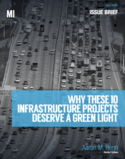It’s been a half century since Ronald Reagan shocked California, and the nation, by beating the late Pat Brown for governor by a million votes. Yet although the Republican Party is a shadow of its mid-20th century form, there are some clear signs that growing discontent — including among independents and many Democrats today — with the regime forged by Brown’s son Jerry, with which so many progressives are deeply enamored. read more »
Looking Beyond One-Party Rule In California
- Login to post comments
The Urban Humanism Manifesto: Putting Communities First
Urban planning exists to serve people and communities, not the other way around. Unfortunately, urban planners these days, perhaps under the influence of academic arrogance as well as the lure of developer dollars, seem to forget this simple truism. read more »
- Login to post comments
Where Talent Wants To Live
With unemployment down and wages rising, there’s growing concern that a lengthy and potentially crippling talent shortage will sweep the U.S. Addressing this could become a critical issue for businesses competing with Asian and European firms facing similar and, in many ways, more severe shortages. read more »
- Login to post comments
Poverty is Worse than Sprawl: California's Housing Affordability Crisis
Rent control supporters in California recently announced that they have enough signatures to qualify a state proposition to remove limitations on municipalities to control rents. Their purpose is to improve housing affordability in the nation’s most unaffordable state. However, should the proposition pass, the net effect is likely to be less new rental housing, as investors are likely to flee the market, as they routinely have before. read more »
- Login to post comments
Chicago, Detroit and the Rust Belt Bifurcated City
So I got into a rather interesting discussion last week in the comments section of Aaron Renn's Urbanophile website in a piece he wrote about population transformation in Pittsburgh and Chicago. And it led to some, well, interesting points that deserve more comment. read more »
- Login to post comments
California Not The Model For America It Thinks It Is
In the past, wrote historian Kevin Starr, California “was a final frontier: of geography and of expectation.” Today in the Trump era, California remains a frontier, but increasingly one that appeals largely to progressives. “California,” recently suggested progressive journalists Peter Leyden and Ruy Teixeira, “today provides a model for America as a whole.” read more »
- Login to post comments
New Localism and Old Institutions
Last week I posted an article talking about the maturity curve, or the lifecycle arc from incubation to growth to maturity to decline that applies to so many things. And this weekend my review of Bruce Katz and Jeremy Nowak’s book The New Localism was published in the New York Times Book Review. These two items are related. read more »
- Login to post comments
The Midwest Is Booming—Just Not Where You Think
The Midwest is booming, but not where you might think. Kansas City, Minneapolis, Indianapolis, Columbus, Grand Rapids, and Des Moines are the fastest-growing cities in the Midwest—lapping bigger hubs like Detroit, Cleveland, Buffalo, Pittsburgh, St. Louis, and even Chicago that are still suffering from stagnant economies and slow or even negative population growth. read more »
- Login to post comments
Giving Common Sense a Chance in California
In California, where Governor Jerry Brown celebrates “the coercive power of the state” and advocates “brainwashing” for the unanointed, victories against Leviathan are rare. Yet last week brought just such a triumph, as a legislative committee rejected an attempt by San Francisco state senator Scott Wiener to take zoning power away from localities in areas within a half-mile of a bus or train stop. read more »
- Login to post comments
Ten Infrastructure Projects We Should Actually Build
I have argued that the primary infrastructure need in the US is for maintenance, not new builds or expansion. But clearly building nothing new isn’t realistic, so what projects should we build and why?
I just released a new Manhattan Institute issue brief highlighting some criteria for when new infrastructure can be justified, along with a list of 10 specific projects that make sense. I include transit, freight rail, highways, airports, and energy on the list. read more »
- Login to post comments





















